教学管理系统毕业设计(论文)任务书
- 格式:doc
- 大小:2.06 MB
- 文档页数:79
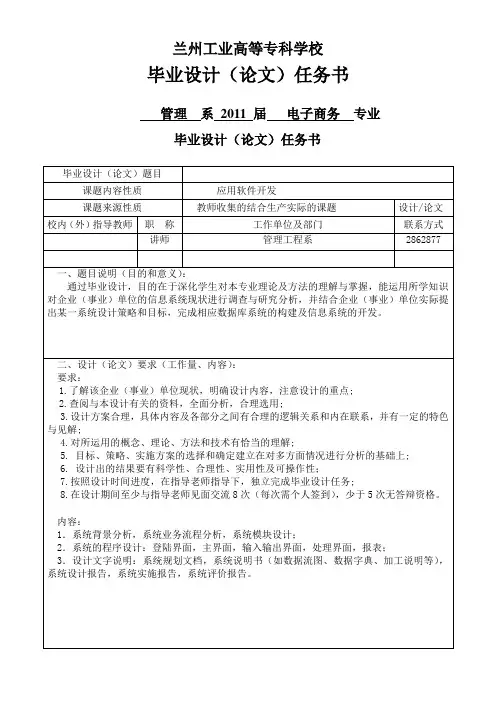
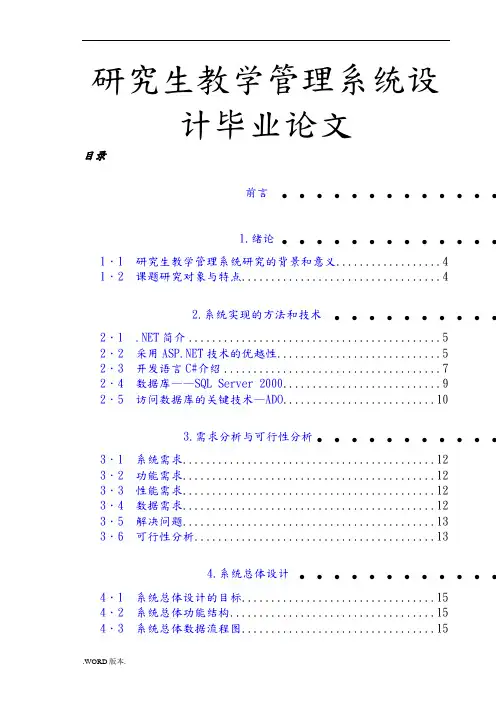
研究生教学管理系统设计毕业论文目录前言.............1.绪论.............1.1 研究生教学管理系统研究的背景和意义 (4)1.2 课题研究对象与特点 (4)2.系统实现的方法和技术..........2.1 .NET简介 (5)2.2 采用技术的优越性 (5)2.3 开发语言C#介绍 (7)2.4 数据库——SQL Server 2000 (9)2.5 访问数据库的关键技术—ADO (10)3.需求分析与可行性分析...........3.1 系统需求 (12)3.2 功能需求 (12)3.3 性能需求 (12)3.4 数据需求 (12)3.5 解决问题 (13)3.6 可行性分析 (13)4.系统总体设计............ 4.1 系统总体设计的目标 (15)4.2 系统总体功能结构 (15)4.3 系统总体数据流程图 (15)4.4 数据库设计 (16)4.4.1 概念结构设计 (17)4.4.2 逻辑结构设计 (18)5.系统详细设计............ 5.1 用户界面设计 (22)5.1.1 用户登陆界面 (22)5.1.2 系统主界面 (22)5.2 功能模块详细设计 (23)5.2.1 系统设置模块 (23)5.2.2 基础信息模块 (26)5.2.3 培养方案管理模块 (28)5.2.4 开课计划管理模块 (30)5.2.5 选课管理模块 (32)5.2.6 成绩管理模块 (33)6.系统测试.............6.1 系统测试的目的和意义 (36)6.2 系统测试的原则 (36)6.3 系统测试的方法 (36)6.4 系统测试的步骤 (37)6.5 测试方案设计 (38)6.5.1 测试方案 (38)6.5.2 测试项目 (38)6.5.3 测试机构及人员 (38)6.5.4 测试项目说明 (38)结论 .............致谢 .............参考文献.............附录一:部分主要代码......................附录二:英文翻译.1.绪论1.1 研究生教学管理系统研究的背景和意义随着研究生招生专业的不断增加和研究生人数的扩大,以前研究生教学的种种弊病逐渐暴露出来,为了使我校研究生的教学工作能够有条不紊的进行,提高研究生教学管理工作的效率,开发一个研究生教学管理系统是一项非常紧迫的任务。
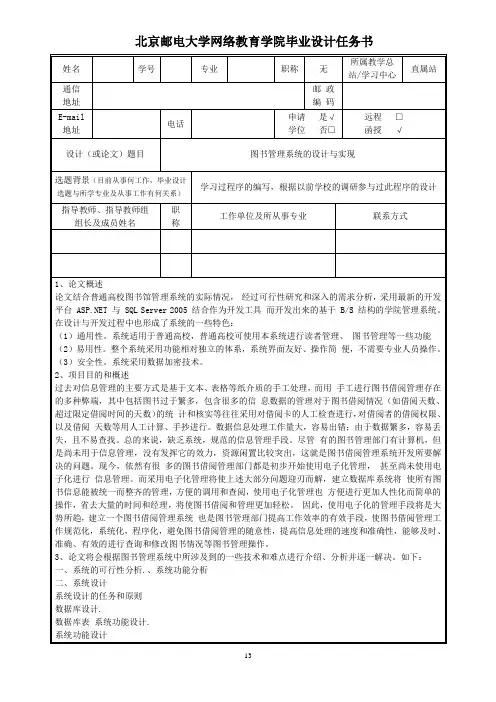
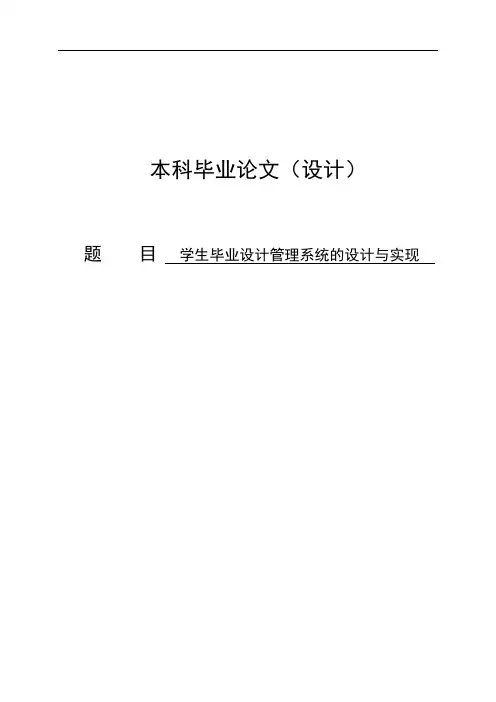
本科毕业论文(设计)题目学生毕业设计管理系统的设计与实现毕业设计(论文)原创性声明和使用授权说明原创性声明本人郑重承诺:所呈交的毕业设计(论文),是我个人在指导教师的指导下进行的研究工作及取得的成果。
尽我所知,除文中特别加以标注和致谢的地方外,不包含其他人或组织已经发表或公布过的研究成果,也不包含我为获得及其它教育机构的学位或学历而使用过的材料。
对本研究提供过帮助和做出过贡献的个人或集体,均已在文中作了明确的说明并表示了谢意。
作者签名:日期:指导教师签名:日期:使用授权说明本人完全了解大学关于收集、保存、使用毕业设计(论文)的规定,即:按照学校要求提交毕业设计(论文)的印刷本和电子版本;学校有权保存毕业设计(论文)的印刷本和电子版,并提供目录检索与阅览服务;学校可以采用影印、缩印、数字化或其它复制手段保存论文;在不以赢利为目的前提下,学校可以公布论文的部分或全部内容。
作者签名:日期:学位论文原创性声明本人郑重声明:所呈交的论文是本人在导师的指导下独立进行研究所取得的研究成果。
除了文中特别加以标注引用的内容外,本论文不包含任何其他个人或集体已经发表或撰写的成果作品。
对本文的研究做出重要贡献的个人和集体,均已在文中以明确方式标明。
本人完全意识到本声明的法律后果由本人承担。
作者签名:日期:年月日学位论文版权使用授权书本学位论文作者完全了解学校有关保留、使用学位论文的规定,同意学校保留并向国家有关部门或机构送交论文的复印件和电子版,允许论文被查阅和借阅。
本人授权大学可以将本学位论文的全部或部分内容编入有关数据库进行检索,可以采用影印、缩印或扫描等复制手段保存和汇编本学位论文。
涉密论文按学校规定处理。
作者签名:日期:年月日导师签名:日期:年月日注意事项1.设计(论文)的内容包括:1)封面(按教务处制定的标准封面格式制作)2)原创性声明3)中文摘要(300字左右)、关键词4)外文摘要、关键词5)目次页(附件不统一编入)6)论文主体部分:引言(或绪论)、正文、结论7)参考文献8)致谢9)附录(对论文支持必要时)2.论文字数要求:理工类设计(论文)正文字数不少于1万字(不包括图纸、程序清单等),文科类论文正文字数不少于1.2万字。
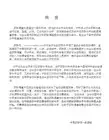
西安科技大学高新学院 毕业设计(论文)任务书
系 别: 机电信息学院 专 业: 计算机科学与技术 学 生 姓 名: Xxx 学 号: xxxxxxxxx 设计(论文)题目: 教学管理系统之学生数据管理子系统
起 迄 日 期: 2013年 10月8 日 ~ 2014年 1月10日 设计(论文)地点: 西安科技大学高新学院 指 导 教 师: xx 专业教研室负责人: xxx
发任务书日期: 2013 年 9 月 15 日 任务书填写要求 1.毕业设计(论文)任务书由指导教师根据各课题的具体情况指导学生填写。此任务书应在毕业设计(论文)开始前一周内填好并发给学生; 2.任务书内容必须用黑墨水笔工整书写或按教务处统一设计的电子文档标准格式(可从教务处网页上下载)打印,不得随便涂改或潦草书写,禁止打印在其它纸上后剪贴; 3.任务书内填写的内容,必须和学生毕业设计(论文)完成的情况相一致,若有变更,应当经过所在专业主管领导审批后方可重新填写; 4.任务书内有关“系别”、“专业”等名称的填写,应写中文全称,不能写数字代码。学生的“学号”要写全号,不能只写最后2位或1位数字; 5.任务书内“主要参考文献”的填写,应按照国标GB 7714—87《文后参考文献著录规则》的要求书写,不能有随意性; 6.有关年月日等日期的填写,应当按照国标GB/T 7408—94《数据元和交换格式、信息交换、日期和时间表示法》规定的要求,一律用阿拉伯数字书写。如“2004年3月15日”或“2004-03-15”。 毕 业 设 计(论 文)任 务 书 1.本毕业设计(论文)课题应达到的目的: 使参与毕业设计的学生对利用JAVA和SQL SERVER开发基于网络的数据库管理系统的开发过程有个基本认识,对于关系数据库的理论课进行实际验证。
2.本毕业设计(论文)课题任务的内容和要求(包括原始数据、技术要求、工作要求等):
2.1.学会简单局域网的建设; 2.2.学会利用JAVA进行数据库管理系统开发; 2.3.会使用SQL SERVER建库、建表、建存储过程、建关系数据库结构; 2.4.学会通过SQL SERVER客户端管理数据库,进行数据库操作; 2.5.学会JAVA在数据库方面的基本编程; 2.6.提供一套能够任课学生数据管理系统,并能生成教学用各类表格(任务); 2.7.提供所用数据库表的详细数据结构; 2.8.提供基于BS的简单管理界面(包括对学生数据输入、修改、打印、删除、授权管理); 2.9.提供基于BS的简单管理界面(包括学生表格的自动生成,修改、打印、删除、授权管理); 2.10为下一步教学管理系统预留接口。 毕 业 设 计(论 文)任 务 书 3.对本毕业设计(论文)课题成果的要求〔包括毕业设计、论文、图表、实物样品等〕:
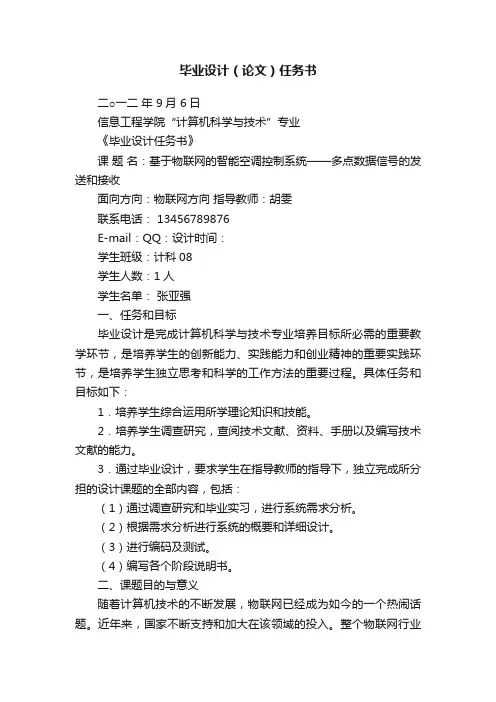
毕业设计(论文)任务书二○一二年 9月 6日信息工程学院“计算机科学与技术”专业《毕业设计任务书》课题名:基于物联网的智能空调控制系统——多点数据信号的发送和接收面向方向:物联网方向指导教师:胡雯联系电话:134****9876E-mail:QQ:设计时间:学生班级:计科08学生人数:1人学生名单:张亚强一、任务和目标毕业设计是完成计算机科学与技术专业培养目标所必需的重要教学环节,是培养学生的创新能力、实践能力和创业精神的重要实践环节,是培养学生独立思考和科学的工作方法的重要过程。
具体任务和目标如下:1.培养学生综合运用所学理论知识和技能。
2.培养学生调查研究,查阅技术文献、资料、手册以及编写技术文献的能力。
3.通过毕业设计,要求学生在指导教师的指导下,独立完成所分担的设计课题的全部内容,包括:(1)通过调查研究和毕业实习,进行系统需求分析。
(2)根据需求分析进行系统的概要和详细设计。
(3)进行编码及测试。
(4)编写各个阶段说明书。
二、课题目的与意义随着计算机技术的不断发展,物联网已经成为如今的一个热闹话题。
近年来,国家不断支持和加大在该领域的投入。
整个物联网行业的产值也在每天以很高的速度增长,这都说明物联网在人们未来的生活中将会起到很重要的作用。
物联网的发展将在人工智能和节能环保方面有着很重要的作用。
“智能家居”这个概念已经被提出好长时间了,而空调就是的管理将是智能家电中的一个很重要的环节。
本项目从空调的远程控制与管理以及一系列自动化调控着手,探索智能家居中的物联网技术。
三、子课题选题原则1.本课题是从实际操作中提出的应用型题目。
在内容的深度和广度上都符合教学要求。
2.因课题涉及面广,鼓励一人一题。
不过也允许多人合选一个子课题(如电子商务网站平台的开发)共同完成。
但多人合选一个子课题时,每人至少完成该课题中的一个子模块,实行任务分配制。
3.本课题主要面向网站应用型人才。
四、分组及模块划分本课题依学生具体情况,分组分模块进行设计。
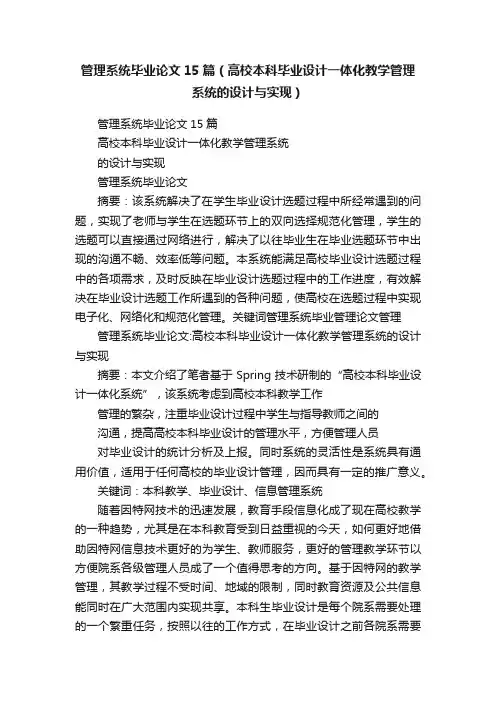
管理系统毕业论文15篇(高校本科毕业设计一体化教学管理系统的设计与实现)管理系统毕业论文15篇高校本科毕业设计一体化教学管理系统的设计与实现管理系统毕业论文摘要:该系统解决了在学生毕业设计选题过程中所经常遇到的问题,实现了老师与学生在选题环节上的双向选择规范化管理,学生的选题可以直接通过网络进行,解决了以往毕业生在毕业选题环节中出现的沟通不畅、效率低等问题。
本系统能满足高校毕业设计选题过程中的各项需求,及时反映在毕业设计选题过程中的工作进度,有效解决在毕业设计选题工作所遇到的各种问题,使高校在选题过程中实现电子化、网络化和规范化管理。
关键词管理系统毕业管理论文管理管理系统毕业论文:高校本科毕业设计一体化教学管理系统的设计与实现摘要:本文介绍了笔者基于Spring技术研制的“高校本科毕业设计一体化系统”,该系统考虑到高校本科教学工作管理的繁杂,注重毕业设计过程中学生与指导教师之间的沟通,提高高校本科毕业设计的管理水平,方便管理人员对毕业设计的统计分析及上报。
同时系统的灵活性是系统具有通用价值,适用于任何高校的毕业设计管理,因而具有一定的推广意义。
关键词:本科教学、毕业设计、信息管理系统随着因特网技术的迅速发展,教育手段信息化成了现在高校教学的一种趋势,尤其是在本科教育受到日益重视的今天,如何更好地借助因特网信息技术更好的为学生、教师服务,更好的管理教学环节以方便院系各级管理人员成了一个值得思考的方向。
基于因特网的教学管理,其教学过程不受时间、地域的限制,同时教育资源及公共信息能同时在广大范围内实现共享。
本科生毕业设计是每个院系需要处理的一个繁重任务,按照以往的工作方式,在毕业设计之前各院系需要准备本次毕业设计供学生选择,之后组织学生以有限的课题数进行机械选题。
而在选题过程中,学生与指导教师缺少必要的交互,使学生往往很难只根据课题的题目及简单的课题介绍就充分了解课题具体内容和目的,这种情况造成了学生很难真正了解自己所选的课题所处的领域现状。
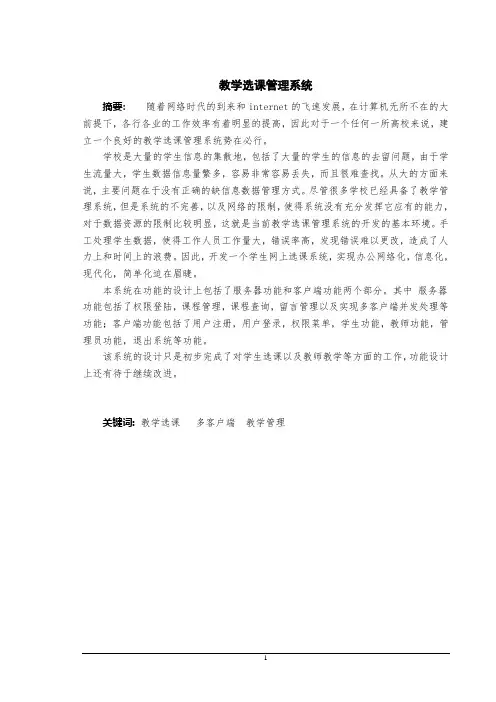
教学选课管理系统摘要:随着网络时代的到来和internet的飞速发展,在计算机无所不在的大前提下,各行各业的工作效率有着明显的提高,因此对于一个任何一所高校来说,建立一个良好的教学选课管理系统势在必行。
学校是大量的学生信息的集散地,包括了大量的学生的信息的去留问题,由于学生流量大,学生数据信息量繁多,容易非常容易丢失,而且很难查找。
从大的方面来说,主要问题在于没有正确的缺信息数据管理方式。
尽管很多学校已经具备了教学管理系统,但是系统的不完善,以及网络的限制,使得系统没有充分发挥它应有的能力,对于数据资源的限制比较明显,这就是当前教学选课管理系统的开发的基本环境。
手工处理学生数据,使得工作人员工作量大,错误率高,发现错误难以更改,造成了人力上和时间上的浪费。
因此,开发一个学生网上选课系统,实现办公网络化,信息化,现代化,简单化迫在眉睫。
本系统在功能的设计上包括了服务器功能和客户端功能两个部分。
其中服务器功能包括了权限登陆,课程管理,课程查询,留言管理以及实现多客户端并发处理等功能;客户端功能包括了用户注册,用户登录,权限菜单,学生功能,教师功能,管理员功能,退出系统等功能。
该系统的设计只是初步完成了对学生选课以及教师教学等方面的工作,功能设计上还有待于继续改进。
关键词: 教学选课多客户端教学管理The design of the teaching course management systemAbstracts:With the rapid development of the Internet era and Internet, in the premis e of the omnipresentcomputer, the efficiency of all walks of life has increased signifi cantly, so for a any one college, be imperative to establish a good teaching course ma nagement system.The school is distributed a large number of students information, including the issu e of the fate of a large number of student information, because the student flow, stud ent data quantity,very easy to get lost, and it is hard to find. On the one hand, the ma in problem is that there is no lack of information data management right. Although the school has a teaching management system, but the system is not perfect, and the li mits of network, the system did not fully play its due ability, for data resource constra ints is obvious, which is the basicenvironment for the development of the teaching cour se management system. The manual processing of student data, making the workloa d, high error rate, error is found difficult to change, resulting in a waste of time an d manpower. Therefore, the development of a studentelective system, realize office net work, informatization, modernization, simple imminent.In the design of function of this system includes two parts function and the functi on of clientserver. The server includes the login, curriculum management, curriculum in quiry, message management and implementation of multi client concurrent processing and other functions;the client functions include user registration, user login, access the menu function, students,teachers, administrators, exit the system functions.The system design is completed the initial selection of students and teachers and other aspects of the work, the functional design needs to continue to improve.Keywords: multi client teaching management teaching course目录1前言 (1)2系统概述 (2)2.1构建目的 (2)2.2项目的开发环境: (2)3系统需求分析 (3)4总体设计 (4)5详细设计 (5)5.1.1权限登录 (5)5.1.2课程管理 (5)5.1.3课程查询 (5)5.1.4留言管理 (6)5.1.5实现多客户端并发处理 (6)5.2客户端功能 (6)5.2.1用户注册 (6)5.2.2用户登录 (7)5.2.3权限菜单 (7)5.2.4学生功能 (7)5.2.5教师功能 (11)5.2.6管理员功能 (13)5.2.7退出系统 (15)6系统测试及运行 (16)6.1系统测试 (16)6.1.1测试目的 (16)6.1.2测试过程 (16)6.2系统运行 (17)结束语 (18)参考文献 (19)附录 (20)致谢 (22)1前言我们每一年的网上选课等工作开始的时候,尤其是在大量学生知道可以网上选课同时登陆的时候,很容易导致学校网站的暂时性崩溃,从而导致学校工作无法正常进行,学生选课时间遭到延后。
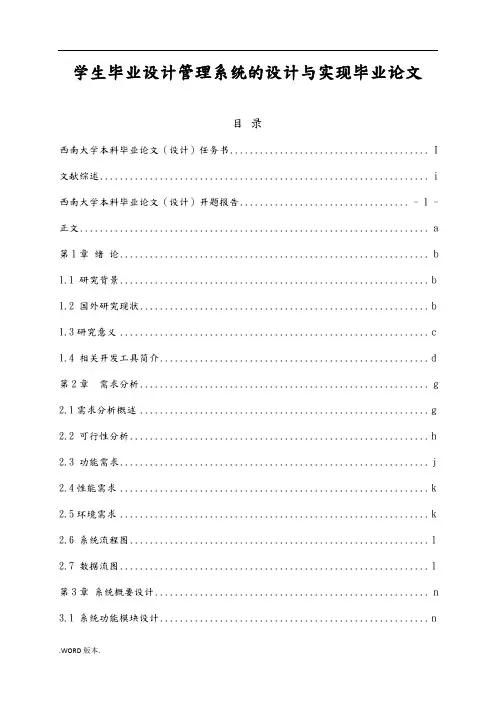
学生毕业设计管理系统的设计与实现毕业论文目录西南大学本科毕业论文(设计)任务书 (I)文献综述 (i)西南大学本科毕业论文(设计)开题报告.................................. - 1 - 正文...................................................................... a 第1章绪论.............................................................. b 1.1 研究背景.............................................................. b 1.2 国外研究现状.......................................................... b 1.3研究意义.............................................................. c 1.4 相关开发工具简介...................................................... d 第2章需求分析.......................................................... g 2.1需求分析概述.......................................................... g 2.2 可行性分析............................................................ h 2.3 功能需求.............................................................. j 2.4性能需求.............................................................. k 2.5环境需求.............................................................. k 2.6 系统流程图............................................................ l 2.7 数据流图.............................................................. l 第3章系统概要设计....................................................... n 3.1 系统功能模块设计...................................................... n3.2 各模块具体功能概述.................................................... o 3.3 数据库设计............................................................ r 第4章系统实现.......................................................... bb 4.1 系统登录界面的实现................................................... bb 4.2前台学生模块的实现................................................... bb 4.3 前台教师模块的实现................................................... dd 4.4 后台管理员管理模块的实现............................................. ee 第5章软件测试. (ii)5.1 软件测试概述 (ii)5.2 软件测试的目标....................................................... jj 5.3应用软件测试的方法(黑盒测试和白盒测试)............................. jj 5.4 系统登录测试......................................................... jj 5.5管理员教师和学生管理测试............................................. kk 5.6管理员论文管理测试................................................... ll 5.7 学生选题管理测试..................................................... ll 总结与展望............................................................... nn 参考文献:............................................................... oo 附录..................................................................... pp 致谢..................................................... 错误!未定义书签。
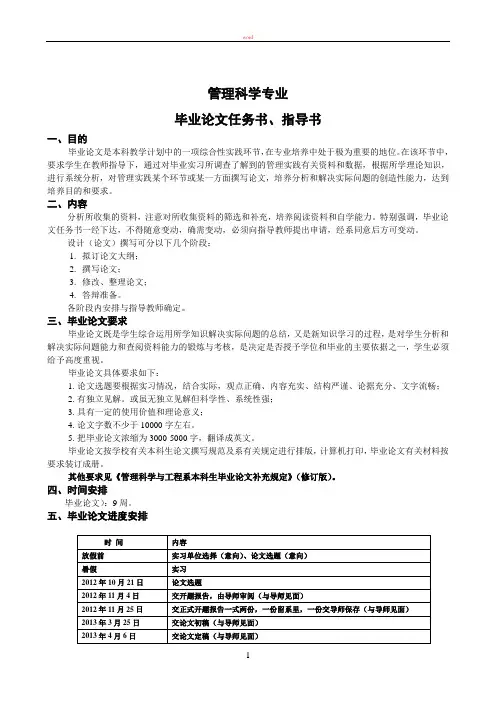
管理科学专业毕业论文任务书、指导书一、目的毕业论文是本科教学计划中的一项综合性实践环节,在专业培养中处于极为重要的地位。
在该环节中,要求学生在教师指导下,通过对毕业实习所调查了解到的管理实践有关资料和数据,根据所学理论知识,进行系统分析,对管理实践某个环节或某一方面撰写论文,培养分析和解决实际问题的创造性能力,达到培养目的和要求。
二、内容分析所收集的资料,注意对所收集资料的筛选和补充,培养阅读资料和自学能力。
特别强调,毕业论文任务书一经下达,不得随意变动,确需变动,必须向指导教师提出申请,经系同意后方可变动。
设计(论文)撰写可分以下几个阶段:1.拟订论文大纲;2.撰写论文;3.修改、整理论文;4.答辩准备。
各阶段内安排与指导教师确定。
三、毕业论文要求毕业论文既是学生综合运用所学知识解决实际问题的总结,又是新知识学习的过程,是对学生分析和解决实际问题能力和查阅资料能力的锻炼与考核,是决定是否授予学位和毕业的主要依据之一,学生必须给予高度重视。
毕业论文具体要求如下:1.论文选题要根据实习情况,结合实际,观点正确、内容充实、结构严谨、论据充分、文字流畅;2.有独立见解。
或虽无独立见解但科学性、系统性强;3.具有一定的使用价值和理论意义;4.论文字数不少于10000字左右。
5.把毕业论文浓缩为3000-5000字,翻译成英文。
毕业论文按学校有关本科生论文撰写规范及系有关规定进行排版,计算机打印,毕业论文有关材料按要求装订成册。
其他要求见《管理科学与工程系本科生毕业论文补充规定》(修订版)。
四、时间安排毕业论文):9周。
五、毕业论文进度安排1.开题报告;2.论文(字数10000字以上);3.调研报告:2篇,字数1000字/篇;4.导师指导纪录:要求导师签署同意答辩意见后,方可由学生本人持此表按照要求将毕业答辩所需的全部材料交到系办公室。
七、毕业论文装订顺序1.封皮2.中文内容摘要和关键词3.英文内容摘要和关键词4.目录5.正文6.参考文献7.调研报告2篇8.本科毕业论文(设计)表1—5()。
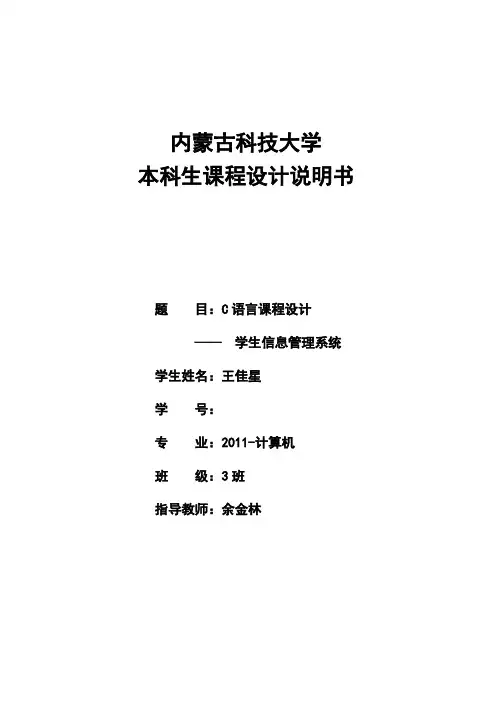
内蒙古科技大学本科生课程设计说明书题目:C语言课程设计——学生信息管理系统学生姓名:王佳星学号:专业:2011-计算机班级:3班指导教师:余金林内蒙古科技大学课程设计任务书目录内蒙古科技大学课程设计任务书 (I)第一章需求分析 (3)1.1引言 (3)1.2任务概述 (3)1.3数据描述 (3)1.4功能需求 (3)1.5性能需求 (3)第二章概要设计 (4)2.1总体设计 (4)2.2数据类型设计(或数据结构设计) (6)2.3接口设计函数声明 (6)2.4运行界面设计 (6)第三章详细设计 (8)3.1输入模块设计 (8)3.2输出模块设计 (8)3.3查找模块设计 (9)3.4保存及读取模块设计 (10)第四章测试分析 (11)4.1测试程序执行情况 (11)第五章课程设计总结 (14)附录:程序代码 (15)参考文献 (26)致谢 (26)第一章需求分析1.1引言学生基本信息管理系统1.2任务概述1.建立学生信息,信息至少包含学生姓名,学号,性别,年龄,出生日期,家庭地址,e-mail,电话地址等;2.能够提供新建、浏览、查找、修改和删除通讯录信息的功能;3.能够提供安不同方式查询的功能;如按姓名或电话等查询;1.3数据描述struct student{char NO[20];char name[20];int age;char sex[3]; *'F'表示性别男,'M'表示性别女*char birthday[10];char address[30];char phone[20];char e_mail[20];struct student *next; 下个结点};1.4功能需求1、输入功能:一次可以完成自定义学生人数的学生信息记录的输入。
2、删除功能:对指定学生的信息进行删除。
3、修改功能:对指定学生的信息进行修改。
4、查询功能:选择某种方式并输入该信息查询符合条件的学生信息。
【关键字】论文
湖南中医药大学
毕业设计(论文)任务书
题目:中南大学湘雅医院妇科病中药处方分析
学院:药学院
专业:药学
班级:10药1
学号:0116
姓名:文娅琪
指导教师:许光明
说明
一、毕业设计(论文)任务书的主要内容和要求、研究方案和目标、参照书目、进度安排由毕业实习指导教师填写,由教师所在专业的学科组审定,经学院领导审核通过后,按专业需要分别下达到各学院管理人员,由各学院管理人员下达到学生。
二、毕业设计(论文)进度表中的“主要工作”栏由学生填写,按期交给指导教师,由指导教师提出指导意见,作为毕业设计(论文)检查工作的重要依据。
三、学生根据指导教师在下达的任务书2周内按时完成开题报告,并交给指导教师批阅。
四、毕业设计(论文)任务书是作为学生重要档案资料,是毕业设计(论文)完整成册的重要材料之一。
说明:参照文献可以附页
此文档是由网络收集并进行重新排版整理.word可编辑版本!。
课程设计管理系统任务书一、教学目标本课程的教学目标是使学生掌握XX学科的基本概念、原理和方法,能够运用所学知识解决实际问题。
具体目标如下:知识目标:1. 掌握XX学科的基本概念和原理;2. 了解XX学科的发展历程和现状;3. 熟悉XX学科的实验方法和技巧。
技能目标:1. 能够运用XX学科的知识解决实际问题;2. 具备XX学科的实验操作能力;3. 学会XX学科的科学研究方法和技巧。
情感态度价值观目标:1. 培养对XX学科的兴趣和热情;2. 形成科学的世界观和方法论;3. 增强团队协作意识和能力。
二、教学内容根据课程目标,教学内容主要包括以下几个部分:1.XX学科的基本概念和原理:通过讲解和案例分析,使学生了解XX学科的基本概念和原理,掌握其核心思想。
2.XX学科的发展历程和现状:通过历史回顾和现状分析,使学生了解XX学科的发展过程,了解其在现代社会的应用和发展趋势。
3.XX学科的实验方法和技巧:通过实验操作和数据分析,使学生掌握XX学科的实验方法和技巧,培养其实验操作能力和科学思维。
三、教学方法为了达到上述教学目标,我们将采用以下教学方法:1.讲授法:通过教师的讲解,使学生掌握XX学科的基本概念和原理。
2.讨论法:通过分组讨论和课堂讨论,激发学生的思考,培养其团队协作能力和科学思维。
3.案例分析法:通过分析实际案例,使学生了解XX学科的应用和实践,提高其解决实际问题的能力。
4.实验法:通过实验操作和数据分析,培养学生的实验操作能力和科学思维。
四、教学资源为了支持教学内容和教学方法的实施,我们将准备以下教学资源:1.教材:选用国内权威的XX学科教材,为学生提供系统的学习资料。
2.参考书:推荐学生阅读相关的参考书籍,丰富其知识体系。
3.多媒体资料:制作课件和教学视频,提高课堂教学的趣味性和互动性。
4.实验设备:准备充足的实验设备,确保每个学生都能动手操作,提高其实验能力。
五、教学评估本课程的评估方式包括平时表现、作业和考试等,旨在全面客观地评估学生的学习成果。
广西电力职技术学院电力工程系毕业设计任务书课题名称基于单片机的物料输送系统电气工程设计专业电气自动化班级 710班学号 203071038姓名覃佳桃指导教师(签名)年月日教研室主任(签名)年月日任务书填写要求1、毕业设计(论文)任务书由指导教师根据各课题的具体情况填写,经学生所在专业的负责人审查、系主管领导签字后生效。
此任力书应在毕业综合实践开始前一周内填好并发给学生;2、任务书内容必须用黑墨水笔工整书定或按统一设计的电子文档标准格式打印,不得随便涂改或潦草书写,禁止打印在其它纸上后剪贴;3、任务书内填写的内容,必须和学生毕业设计(论文)任务完成的情况相一致,若有变更,应当经过所在专业及系统主管领导审批后方可重新填写;4、任务书内有关“系”、“专业”等名称的填写,应写中文全称,不能写数字代码,学生的“学号”要写全号,请规范化填写;5、任务书内“主要参考文献”的填写,应按国标GB7714—87《文后参考文献著录规则》的要求书写,不能有随意性;6、有关年月日等日期的填写,应当按国标GB/T7408—94《数据元和交换格式、信息交换、日期和时间表示法》规定的要求,一律用阿拉伯数字书写。
如“2002年4月2日”或“2002-04-02”。
毕业设计(论文)的有关说明一、毕业设计(论文)的性质和目的毕业设计(论文)是高等职业学校培养工科应用型学生的一个重要实践性教学环节,是在学生学完全部课程,并完成必要的课程设计和实习、实训的基础上进行的。
毕业综合实践作为高等职业教育教学过程中的最后一个教学环节,与其他教学环节彼此配合,是前面各个教学环节的继续、深化和提高,其内容应符合专业培养目标与规格要求。
毕业设计(论文)环节,除可以培养和锻炼学生综合应用所学的专业理论和技能、独立工作的能力和创造能力外,还能培养学生良好的职业道德、意志品质、心理承受能力和团结协作精神等,使他们毕业后能尽快地适应工作岗位。
毕业设计(论文)的基本教学目的是培养学生综合运用所学的基础理论、专业知识和基本技能,提高分析与解决生产、建设、服务、管理第一线的实际问题的能力和形成综合职业素质。
文档编号:0000 184优秀毕业设计华南理工大学毕业论文任务书目录目录 (2)华南理工大学(设计)论文任务书 (模板一) (2)华南理工大学(设计)论文任务书 (模板二) (6)华南理工大学(设计)论文任务书 (模板三) (9)华南理工大学(设计)论文任务书 (模板四) (10)华南理工大学(设计)论文任务书 (模板五) (12)华南理工大学(设计)论文任务书 (模板六) (14)华南理工大学(设计)论文任务书 (模板七) (15)华南理工大学(设计)论文任务书 (模板八) (17)华南理工大学(设计)论文任务书 (模板九) (19)华南理工大学(设计)论文任务书 (模板十) (21)本文精选了华南理工大学各个学院毕业(设计)论文任务书,总共10个不同类别的任务书模板范文,都选自华南理工大学同学的优秀毕业论文,包含各个专业类别的任务书,适合各个学院同学们撰写毕业设计论文时参考和研究。
撰写毕业论文是检验学生在校学习成果的重要措施,也是提高教学质量的重要环节。
大学生在毕业前都必须完成毕业论文的撰写任务。
申请学位必须提交相应的学位论文,经答辩通过后,方可取得学位。
愿此文能助毕业班同学们一臂之力,欢迎下载。
华南理工大学(设计)论文任务书 (模板一) (包括原始数据、技术要求、工作要求)华南理工大学(设计)论文任务书 (模板二)编号: 2014230302112论文(设计)题目:分块矩阵及其应用学院:数理学院专业:数学与应用数学班级: 2013级2班学生姓名:杜宗飞学号: 2013511523 指导教师:刘欢欢职称:讲师1、论文(设计)研究目标及主要任务研究目标:总结分析分块矩阵在计算和证明中的应用。
主要任务:利用矩阵分块解决线性代数中的相关问题,给出相应定理、证明及实例,体现分块矩阵在线性代数中的重要性。
2、论文(设计)的主要内容本论文重点就分块矩阵在计算行列式、证明相关矩阵秩的不等式、求矩阵的逆、分块矩阵在解线性方程组的应用等方面的应用进行了分析总结,通过引入实例说明对矩阵进行适当的分块可以使高等代数中的许多计算和证明问题迎刃而解。
毕业设计(论文)任务书(模板)任务书(模板)任务书编号:任务书名称:日常物品的图像识别解决方案及其实现教学部门:计算机学院课程名称:毕业设计(论文)项目年度:20xx年度指导教师:XXX学生姓名:XXX学号:XXXXXX一、项目背景与意义近年来,随着生活水平的不断提高和科学技术的发展,人们对于日常物品的质量、效果和安全等方面的要求也越来越高。
目前,市场上还存在着部分质量差、效果不佳或者存在安全隐患的商品。
为提高消费者的购物体验、降低消费者的风险,实现商品的质量和标准的普及,需要对日常物品进行分类和识别,进一步提高商品的管理和监督。
因此,本课题设计了一种基于图像识别技术的日常物品分类与识别系统,旨在解决目前日常物品分类和识别存在的问题,使其变得更加便捷和高效。
二、项目任务及要求1. 分析当下市场上针对日常物品分类与识别的技术,并设计一种基于图像识别技术的日常物品分类与识别系统。
2. 实现系统中的图像特征提取、分类与识别算法模块,并进行优化和改进,提升系统的准确性和效率。
3. 考虑系统的可用性和易用性,设计系统界面,并实现对用户的友好操作。
4. 对系统性能进行评价,验证系统的准确性、效率以及可靠性等指标。
三、实施计划1. 前期准备:熟悉相关文献,对日常物品分类与识别的算法进行分析和比较。
对已有的处理流程和代码进行分析和修改,为系统的设计和实现做好准备。
预计时间为两周。
2. 系统设计:根据日常物品分类与识别的需求,进行系统的分析和设计,明确系统的功能、流程、界面和性能等方面的要求。
设计并实现日常物品图像数据集的收集与处理,选取适合的图像识别算法,并进行改良。
预计时间为两周。
3. 系统实现:根据设计需求完成系统功能模块的实现和集成,包括图像特征提取算法模型、分类与识别模块和用户界面模块等。
预计时间为四周。
4. 实验评估:对系统进行可靠性和效率等方面的测试,对系统性能进行量化分析和评估。
预计时间为两周。
5. 撰写论文:总结研究中的过程、结果和创新点,把研究成果通过撰写论文的形式呈现出来。
大连交通大学信息工程学院 毕业设计(论文)任务书
题 目 蒙奇奇教学管理系统 任务及要求: 1.设计(研究)内容和要求 任务: 1、调查蒙奇奇教学管理系统的近况,完成实习报告,字数不少于3000,第三周交给指导老师。 2、结合自己实习情况安排进度,填写进度计划表,第二周完成后交给指导老师签字,并严格执行。 3、按照软件工程思想,独立完成系统的设计和程序开发,完成代码估计2000行左右。 4、用JSP技术实现基于教学中排课、选课等基本功能。 5、程序简洁,算法可行,运行情况良好。
要求: 1、 每周和指导老师至少见面沟通一次,回报课题进展情况,接受老师询问。 2、 接到任务书后,查阅与题目及专业相关的外文资料进行翻译,要求不少于10000个外文字符,译出汉字不得少于3000,于第四周交给指导老师审阅。 3、 毕业设计第13周完成毕业论文的装订,并由指导老师评阅。论文要求12000字以上,包括综述、系统总体设计、系统实现、性能分析、结论等。 4、 教学第13周通过中软及教研室组织进行软件验收,验收时要提供软件使用说明书。 5、 于第13周提出毕业答辩申请并签字。 6、 第14 周答辩,要求制作PPT
2.原始依据 通过大学几年的学习,已经学习了诸如软件工程、数据库原理及应用、数据结构、C++、Visual Basic、JAVA等多门程序设计语言和网络等基础知识和专业知识,学生有能力而且可以独立完成小中型项目的设计与开发。学校现有设备和环境可以提供给学生实习和上机,而且具有专业老师可以指导学生。 3.参考文献 [1] 李发致.项目管理教程.电子工业出版社.2005.2 [2] 张怀庆.java案例精粹150例.北京冶金工业出版社.2005.2 [3] 张孝祥.JSP项目管理培训教程.清华大学出版社.2008.6 [4] 王建 张金波.java程序设计实训教程.北京海洋出版社.2006.01 [5] Bernd Bruegge.面向对象软件工程.清华大学出版社.2003.7 [6] Campbell R.Mconnell Stanley L.Brue.Micro-Economics[J].set in century oldstyle by York Graphic Services.2000 [7] 仝春灵,沈祥玖.数据库原理与应用—MySQL.中国水利水电出版社.2003 [8] 耿祥义,张跃平.JAVA2实用教程[M].清华大学出版社.2006 [9] 楼兴华.MySQL数据库系统开发实例导航[M].人民邮电出版社.2004 [10] 钱雪忠.数据库原理及应用[M].北京邮电大学出版社.2008
指导教师签字: 教研室主任签字: 2012年3月26日
大连交通大学信息工程学院 毕业设计(论文)进度计划与考核表 学生姓名 冯程程 专业班级 软件工程 08-1班 指导教师 杨 迪 李孝贵 本课题其他人员 无 题 目 蒙奇奇教学管理系统 日 期 计划完成内容 完成情况 指导老师检查签字
第1周 拟订《毕业论文进度计划与考核表》
第2周 完成实习或调研报告 第3周 提交外文文献翻译资料 第4周 系统概要设计阶段 第5周 系统详细设计阶段 第6周 系统编码实施、完成论文初稿 第7周 完成系统编码实施 第8周 系统编码调试、提交论文初稿 第9周 完成系统编码调试、完善毕业论文 第10周 完成撰写毕业设计论文编写及代码测试 第11周 完成论文终稿、准备毕业论文打印、装订 第12周 提交毕业论文终稿及代码 第13周 完成毕业论文 第14周 毕业论文答辩
指导教师签字: 年 月 日 注:“计划完成内容”由学生本人认真填写,其它由指导教师考核时填写。 大连交通大学信息工程学院 毕业设计(论文)外文翻译
学生姓名 冯程程 专业班级 软件工程08-1班 指导教师 杨迪 李孝贵 职 称 高工 助教 所在单位 信息科学系软件工程教研室 教研室主任 刘瑞杰
完成日期 2012 年 4 月 13 日 The Web application and the development
In this paper we present and discuss a template/meta-data based partial code generation system supporting web application development. Seamlessly incorporating the recent top-notch technologies, the framework maximally exploits the capabilities of the underlying implementation technologies. Our approach primarily benefits the framework and code developers. In addition, the complete separation of data model, navigation model, and presentation model reflects on a more general conceptual process that would decouple the technique and methodology from its underlying technology choices. The decoupling between the generated code and the code that is necessarily added later on through other development pathways than the generator deals with the incremental changes and adaptations of the models in the face of an operational system, therefore further enhances the extensibility, maintainability, and reusability of the generated applications. Categories and Subject Descriptors Involving with multiple disciplines relating to the computing and networking technologies, the development of web applications can be quite complex, costly and time-consuming, if not supported by a practical methodology [9]. In order to increase the productivity of web application development, a wealth of languages and standards and techniques have been created. On the basis of our consulting experience in industry, we believe that the following technologies dominate in the present web application realm. The Java 2 platform, Enterprise Edition (J2EE) defines de facto standard software architecture for multi-tier interactive web applications [16]. Meanwhile, application servers, which most commercial products available today are based on the J2EE platform, provide system-level environmental support for web application development that prevent developers from tedious coding of system level utilities [13]. According to the J2EE paradigm, the architecture of a typical web application reflects the traditional three-tier architectural model [15]: front-end, middle tier, and back-end. The Hyper-Text Markup Language (HTML),JSP, and JavaScript provide powerful means to describe dynamic web interfaces for applications; and Java Servlet provides underlying support to construct web page information on the fly. The concepts of session bean and entity bean in EJB technique clearly decouple the code serving for business logic processing from the code of data, thus provide a commanding infrastructure to construct the middle-tier of applications. Furthermore, the EJB engine provides a higher-level abstraction over the underlying data model storage devices – the traditional relational database, which is considered to be the back-end of a web application. In addition, some other techniques further assist to firm the J2EEbased development methodology, such as Struts [23], Ant [1], and XML [21]. Struts provides an open source unified front-end Model-View-Controller (MVC) framework [10] for web applications. Ant is a Java based prompt build tool that allows developers to utilize XML technique to configure the relationships between different building blocks and generate the compiled version. As a universal description language, XML provides a de facto standard language to define and describe web applications. J2EE-based techniques have enabled the explosion in the number of web applications that we